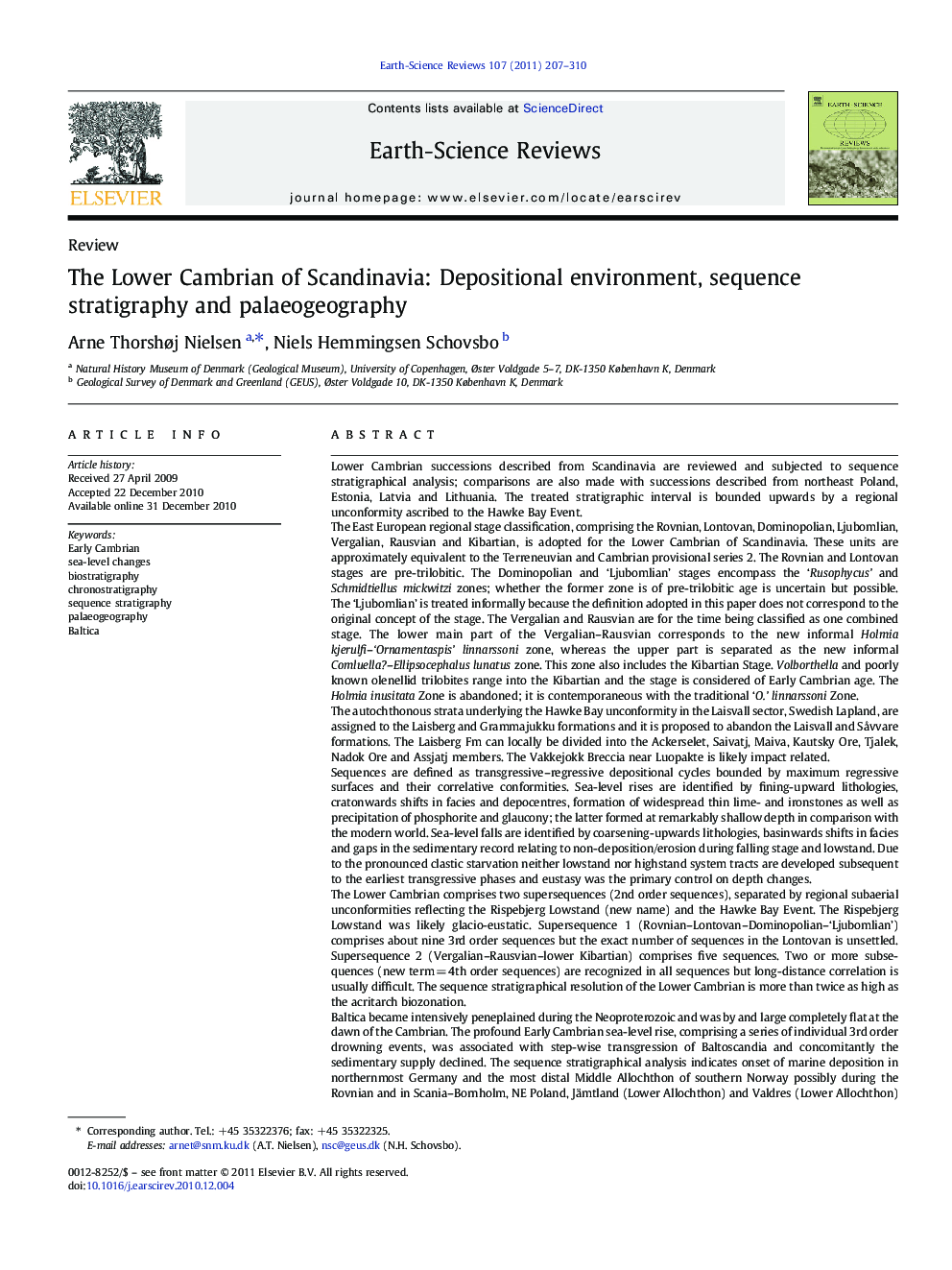| کد مقاله | کد نشریه | سال انتشار | مقاله انگلیسی | نسخه تمام متن |
|---|---|---|---|---|
| 4726032 | 1640001 | 2011 | 104 صفحه PDF | دانلود رایگان |

Lower Cambrian successions described from Scandinavia are reviewed and subjected to sequence stratigraphical analysis; comparisons are also made with successions described from northeast Poland, Estonia, Latvia and Lithuania. The treated stratigraphic interval is bounded upwards by a regional unconformity ascribed to the Hawke Bay Event.The East European regional stage classification, comprising the Rovnian, Lontovan, Dominopolian, Ljubomlian, Vergalian, Rausvian and Kibartian, is adopted for the Lower Cambrian of Scandinavia. These units are approximately equivalent to the Terreneuvian and Cambrian provisional series 2. The Rovnian and Lontovan stages are pre-trilobitic. The Dominopolian and ‘Ljubomlian’ stages encompass the ‘Rusophycus’ and Schmidtiellus mickwitzi zones; whether the former zone is of pre-trilobitic age is uncertain but possible. The ‘Ljubomlian’ is treated informally because the definition adopted in this paper does not correspond to the original concept of the stage. The Vergalian and Rausvian are for the time being classified as one combined stage. The lower main part of the Vergalian–Rausvian corresponds to the new informal Holmia kjerulfi–‘Ornamentaspis’ linnarssoni zone, whereas the upper part is separated as the new informal Comluella?–Ellipsocephalus lunatus zone. This zone also includes the Kibartian Stage. Volborthella and poorly known olenellid trilobites range into the Kibartian and the stage is considered of Early Cambrian age. The Holmia inusitata Zone is abandoned; it is contemporaneous with the traditional ‘O.’ linnarssoni Zone.The autochthonous strata underlying the Hawke Bay unconformity in the Laisvall sector, Swedish Lapland, are assigned to the Laisberg and Grammajukku formations and it is proposed to abandon the Laisvall and Såvvare formations. The Laisberg Fm can locally be divided into the Ackerselet, Saivatj, Maiva, Kautsky Ore, Tjalek, Nadok Ore and Assjatj members. The Vakkejokk Breccia near Luopakte is likely impact related.Sequences are defined as transgressive–regressive depositional cycles bounded by maximum regressive surfaces and their correlative conformities. Sea-level rises are identified by fining-upward lithologies, cratonwards shifts in facies and depocentres, formation of widespread thin lime- and ironstones as well as precipitation of phosphorite and glaucony; the latter formed at remarkably shallow depth in comparison with the modern world. Sea-level falls are identified by coarsening-upwards lithologies, basinwards shifts in facies and gaps in the sedimentary record relating to non-deposition/erosion during falling stage and lowstand. Due to the pronounced clastic starvation neither lowstand nor highstand system tracts are developed subsequent to the earliest transgressive phases and eustasy was the primary control on depth changes.The Lower Cambrian comprises two supersequences (2nd order sequences), separated by regional subaerial unconformities reflecting the Rispebjerg Lowstand (new name) and the Hawke Bay Event. The Rispebjerg Lowstand was likely glacio-eustatic. Supersequence 1 (Rovnian–Lontovan–Dominopolian–‘Ljubomlian’) comprises about nine 3rd order sequences but the exact number of sequences in the Lontovan is unsettled. Supersequence 2 (Vergalian–Rausvian–lower Kibartian) comprises five sequences. Two or more subsequences (new term = 4th order sequences) are recognized in all sequences but long-distance correlation is usually difficult. The sequence stratigraphical resolution of the Lower Cambrian is more than twice as high as the acritarch biozonation.Baltica became intensively peneplained during the Neoproterozoic and was by and large completely flat at the dawn of the Cambrian. The profound Early Cambrian sea-level rise, comprising a series of individual 3rd order drowning events, was associated with step-wise transgression of Baltoscandia and concomitantly the sedimentary supply declined. The sequence stratigraphical analysis indicates onset of marine deposition in northernmost Germany and the most distal Middle Allochthon of southern Norway possibly during the Rovnian and in Scania–Bornholm, NE Poland, Jämtland (Lower Allochthon) and Valdres (Lower Allochthon) during the Lontovan. Marine deposition commenced in the Mjøsa District (Lower Allochthon) as well as in Swedish Lapland (Autochthon) during the Dominopolian, and the transgression reached southernmost Gotland early in the Vergalian–Rausvian, whereas Öland, northern Gotland, central Sweden and the Autochthon of the Mjøsa District and Jämtland-western Dalarna were flooded slightly later. The northern Baltic Sea–Bothnian Bay and western Finland were flooded lastly (late Vergalian–Rausvian). A narrow land area straddled the axis of mainland Sweden even during maximum transgression in the latest Early Cambrian. The Digermul area was essentially inundated all through the late Ediacaran–Early Cambrian and represents a Timanide foreland basin.The first Cambrian transgression in the East Baltic area took place in a post-rift sag-basin that formed above the Volhyn–Orcha Rift System during the Rovnian–Lontovan. The rift system inverted during the Dominopolian associated with the formation of a narrow marginal trough centred in the easternmost Baltic Sea. This event was in turn followed by the formation of a wider secondary marginal trough during the early Vergalian–Rausvian, affecting the Öland–Gotland area, and at the same time causing mild uplift of the primary marginal trough in the East Baltic sector. A third sub-regional subsidence event during the late Vergalian–Rausvian stage was centred in the Bothnian Sea and also affected western Finland, parts of south-central Sweden, and the northern Baltic Sea. The Hedmark Basin in southern Norway was seemingly also subjected to mild inversion during the earliest Cambrian. The mentioned subsidence and uplift events were in the size order of a few tens of metres to maximum a few hundreds of metres.The flooding pattern is illustrated in a series of 10 palaeogeographical maps reconstructed for Scandinavia and the East Baltic area including western Russia, western Belorussia, northeast Poland and northwestern Ukraine. The mapping is based on assessment of some 700 data-points in the region. Isopach maps for selected units have also been compiled. The mapping reveals that several of the tectonic windows in the Norwegian–Swedish mountain chain represent original basement highs.The most significant 3rd order sea-level changes are named for easy reference, including the Hadeborg Drowning (Lontovan), Brantevik Drowning (basal Dominopolian), Snogebæk Lowstand (Dominopolian), Norretorp-1 Drowning (Dominopolian), Mid Norretorp Lowstand (terminal Dominopolian), Norretorp-2 Drowning (basal ‘Ljubomlian’), Rispebjerg Lowstand (end ‘Ljubomlian’), Gislöv Drowning (basal Vergalian–Rausvian), Evjevik-1 Drowning (Vergalian–Rausvian), Evjevik-2 Drowning (Vergalian–Rausvian) and the När Lowstand (Rausvian/Kibartian transition).
Journal: Earth-Science Reviews - Volume 107, Issues 3–4, August 2011, Pages 207–310